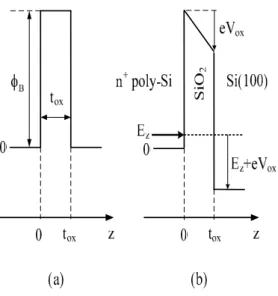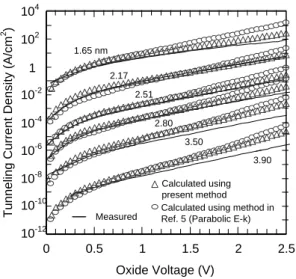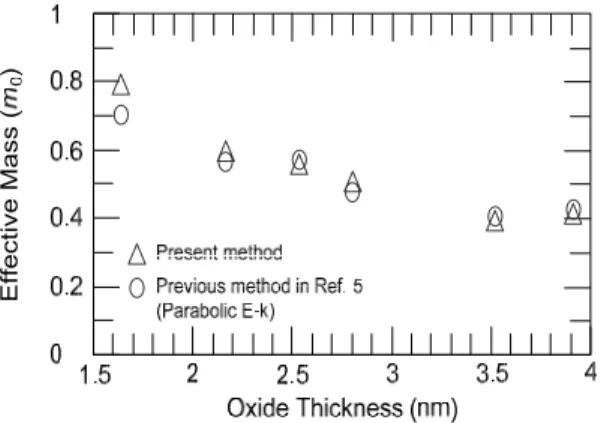404 Fatimah Arofiati Noor et al.
Analysis of Electron Direct Tunneling Current through Very-Thin Gate Oxides in MOS
Capacitors with the Parallel-Perpendicular Kinetic Energy Components and Anisotropic Masses
Fatimah Arofiati Noor, Mikrajuddin Abdullah, Sukirno, and Khairurrijal∗
Physics of Electronic Materials Research Division, Faculty of Mathematics and Natural Sciences, Institut Teknologi Bandung, Jalan Ganesa 10, Bandung 40132, Indonesia
(Received on 30 December, 2009)
An electron direct tunneling current model ofn+−poly−Si/SiO2/p−Si(100)metal-oxide-semiconductor
(MOS) capacitors has been developed by considering a parallel-perpendicular kinetic energy coupling, which is represented by the gate electron phase velocity, and anisotropic masses under a parabolic E-kdispersion relationship. The electron effective mass in the oxide and the electron phase velocity in then+poly−Sigate are the only two fitting parameters to compare calculated tunneling currents to measured ones. It was obtained that the calculated tunneling currents fit well to the measured ones. The electron effective mass in the oxide layer tends to increase with decreasing the oxide thickness. In addition, the gate electron velocity is a constant of 1×105m/s. Moreover, the theoretical model offers a simple treatment and an accurate result in obtaining the tunneling current.
Keywords: gate oxide, anisotropic mass, gate velocity, tunneling current
1. INTRODUCTION
It is well known that a condition for the success of the semiconductor industry is the continuous improvement of in-tegrated circuit performance by simply reducing the feature size of the fundamental switching components, metal-oxide-semiconductor field-effect transistors (MOSFETs) [1]. The miniaturization of device dimensions allows the high perfor-mance at low costs [2]. In order to reach that purpose, the oxide thickness is supposed to be shrunk to 1.5–1.9 nm when the gate length of MOSFETs is scaled down to 100 nm [3]. However, the tunneling current through very thin gate oxides increases exponentially as the oxide thickness decreases at low applied voltages, whereas the transistor performance is significantly enhanced [4]-[5]. In addition, the huge tunnel-ing current in very large scale integrated circuits causes the power consumption becomes significantly high [6]. There-fore, it is required a precise model to foresee the tunneling current for developing future transistor and circuit design.
A theoretical model of tunneling current in the MOS ca-pacitor had been originated since long year ago. Electron transmittance, tunneling time and current in MOS capacitors have been investigated under an isotropic mass approach and without considering a coupling effect between parallel and perpendicular motions by employing the parabolicE-k dis-persion relationship [5], [7]-[11]. However, the tunneling currents in the MOS capacitor fit well to the measured ones only for the oxide voltages less than 1.5 V and get signifi-cantly greater than the measured one at oxide voltages above 1.5 V [5]. The parabolicE-kdispersion relationship becomes commonly used to solve the tunneling problems due to its simplicity. It is known that the non-parabolicE-kdispersion relationship is more accurate than the parabolicE-k disper-sion relationship [5]. However, the non-parabolicE-k disper-sion relationship is more complicated. Therefore, it is neces-sary to find the simple and accurate method in describing the tunneling current.
∗Electronic address:krijal@fi.itb.ac.id
In this paper, we report a theoretical model of tunneling current inn+−poly−Si/SiO2/p−Si(100) structures un-der an anisotropic mass approach and taking into account a parallel-perpendicular kinetic energy components which is represented by the gate electron phase velocity by using the parabolicE-kdispersion relationship. The electron effective mass in the oxide layer and the electron phase velocity in the n+−poly−Sigate, which are two fitting parameters used to fit the theoretical tunneling currents to the measured ones, will be discussed.
2. THEORETICAL MODEL
Figure 1 describes a schematic energy diagram ofn+− poly−Si/SiO2/p−Si(100)structures at zero bias and a neg-ative bias applied to then+−poly−Sigate. Here, the barrier width and height aretoxandφB, respectively,Voxis the oxide
voltage, andeis the electronic charge.
Using a simple electrostatic analysis, the potential profile shown in Figure 1.(b) is mathematically expressed as
V(z) =
0 z<0
φB−eFz 0≤z<tox
−eVox z≥tox,
(1)
whereF=eVox
tox is the electric field in the barrier.
An electron in an anisotropic material under the parabolic-band effective mass approximation is given by [12] :
1 2p
Tα(r)
m0
p+V(r)
Ψ(r) =EΨ(r), (2)
where m0 is the free-electron mass, p is the momen-tum vector, α(r)m0 is the inverse effective-mass tensor, V(r) is the potential energy, and E is the total energy. Since the potential energy is only dependent on the z -direction, the electron wavefunctionΨ(r)is given byΨ(r) =
ψ(z)exp(−iγz)exp(i(kxx+kyy)), where kx and ky are the
wavenumbers in thex- and y-directions, respectively. The termγ= (αxzkx+αyzky)
αzz is the wavenumber in thex-y
Brazilian Journal of Physics, vol. 40, no. 4, December, 2010 405
FIG. 1: Energy band profile of an+−poly−Si/SiO2/p−Si(100)
structure without applied voltage (a) and a negative bias applied to then+−poly−Sigate (b).
Since the total energy E comprises the parallel (the x-y plane) and perpendicular (thez-direction) energies, the wave-function in thez-direction ψ(z)fulfills the one-dimensional Schr¨odinger-like equation that is written as
− ~
2
2m0
αzz
d2ψ(z)
dz2 +V(z)ψ(z) =Ezψ(z), (3) where~is the reduced Planck constant. The perpendicular
energy Ez is then written as Ez=E−∑i,j∈{x,y}
~2
2m0βi jkikj, whereβi j=αi j−
αizαz jα zz
.
Referring to Figure 1.(b) and considering that the total en-ergy of electron is constant, the perpendicular enen-ergy in re-gionn(n∈ {2,3})with respect to that in region 1 is
Ez,n=Ez,1+
~2
2m0i,j∈{
∑
x,y}(βi j,1−βi j,n)kikj. (4)
By substituting Equation (4) into Equation (3), the Schr¨odinger-like equation in regionnis found as
− ~
2
2m0
αzz,n
d2ψ(z)
dz2 +Ve f f(z)ψ(z) =Ez,1ψ(z). (5) Equation (5) contains the coupling between parallel and per-pendicular kinetic energy components of the electron motion in an anisotropic MOS capacitor. The effective potential en-ergyVe f f(z) is written as
Ve f f(z) =V(z)−
∑
i,j∈{x,y}v2em0 2βi j,1
1−βi j,n
βi j,1
, (6)
whereve is the gate electron phase velocity. This effective
potential energy occurs due to the difference of parallel ki-netic energies between regionsnand 1 due to the difference between the effective masses in thex-yplane of regionsn and 1. A complete derivation can be found in Ref. [13].
The electron wavefunction in the z-direction Ψ(z) = ψ(z)exp(−iγz)in each region is given by
Ψ(z) =
{µexp(ik1z) +ηexp(−ik1z)}exp(−iγ1z) z<0
{λAi(ε(z)) +δBi(ε(z))}exp(−iγ2z) 0≤z<tox
{χexp(ik3z)}exp(−iγ3z) z≥tox.
(7)
Here,µ,η,λ,δ, andχare constants, andk1andk3are the wavenumbers in the z-direction in regions 1 and 3, respec-tively, and expressed as
k1=
2m0Ez
~2 1
αzz,1 1/2
, (8)
k3=
1
αzz,3
2m0(Ez+eVox)
~2
+
∑
i,j∈{x,y} v2
em20
~2 1
βi j,1
1−βi j,3 βi j,1
)#1/2
. (9)
The arguments ε(z) of the Airy functions Ai and Bi in
Equation (7) is
ε(z) =
2m0
~2 1
αzz,2 F
1/3
−z+(φB−Ez)
F −
∑
i,j∈{x,y} v2em0
2F 1
βi j,1
1−βi j,2 βi j,1
!
.
(10)
cur-406 Fatimah Arofiati Noor et al.
10-12 10-10 10-8 10-6 10-4 10-2 1 102 104
0 0.5 1 1.5 2 2.5
Oxide Voltage (V)
Tunneling Current Density (A/cm
2 )
Calculated using method in Ref. 5 (Parabolic E-k) Calculated using present method
Measured 1.65 nm
2.17
2.51
2.80
3.50
3.90
FIG. 2: Measured and calculated tunneling current density through 1.65-2.90-nm-thick oxides using the present and previous method under parabolicE-kdispersion relationships. The previous method does not include the parallel-perpendicular kinetic energy coupling and anisotropic masses.
rent by using the following equation [5]: Jz=
e∑lnvlmdl
2π2~3
× Z ∞
0
T(Ez)kTln
(
1+exp
(EF−Ez)kT
1+exp
(EF−Ez−eVox)kT
) dEz,
(11) wherel is the number of valley, nv andmd are the valley
degeneracy and the density-of-states mass per valley, respec-tively, T(Ez)is the electron transmittance,EF is the Fermi
energy of the gate,kis the Boltzmann constant, andT is the temperature. The tunneling current in Equation (11) is eas-ily calculated by employing the Gauss–Laguerre Quadrature method [17].
3. CALCULATED RESULTS AND DISCUSSION
There are six equivalent valleys in the conduction band of Si(100), which are divided into three groups of valleys with the tensor elementsαi jas shown in Table 1 [18]-[20].
The electron effective mass in the oxide layer,mox, and the
phase velocity of an injected electron from then+−poly− Sigate, ve, are the only two fitting parameters to compare
the measured tunneling current with the theoretical one. In order to verify the present model, we used all parameters and measured current densities from Ref. [5].
Figure 2 shows the calculated tunneling currents obtained using the previous method under parabolicE-kdispersion re-lationships fit to the measured ones only in the low oxide voltage regime. Moreover, the calculated tunneling currents employing the present method reveals better fitting to the measured ones. This means that the present method includ-ing the parallel-perpendicular kinetic energy couplinclud-ing and
Valley Si(100)
V1
1.02 0 0
0 5.26 0
0 0 5.26
V2
5.26 0 0
0 1.02 0
0 0 5.26
V3
5.26 0 0
0 5.26 0
0 0 1.02
Table 1. Tensor elements αijof Si(100)
anisotropic masses offers more accurate calculations for tun-neling current in particular at high voltage regimes. For all oxide thicknesses, the fitted value of the injected electron ve-locityveis 1×105m/s, independent of the oxide thickness.
Figure 3 depicts the measured and calculated tunneling currents obtained using the present method under anisotropic masses and considering a coupling between parallel and per-pendicular motions by employing the parabolicE-k disper-sion relationship, and the previous method without includ-ing the parallel-perpendicular kinetic energy couplinclud-ing and anisotropic masses by using the non-parabolicE-kdispersion relationship. It is shown that the obtained tunneling currents under present method are almost the same as those obtained under the previous method. Noting that the non-parabolic E-kdispersion relationship is more accurate and complicated than the parabolicE-kdispersion relationship as given in Ref. [5], the present model gives the simple treatment and accu-rate results in calculating the tunneling current.
FIG. 3: Measured and calculated tunneling currents using the present method by employing the parabolicE-k dispersion rela-tionship, and the previous method by using the non-parabolicE-k
dispersion relationship without including the parallel-perpendicular kinetic energy coupling and anisotropic masses.
Brazilian Journal of Physics, vol. 40, no. 4, December, 2010 407
thicker than 3.5 nm is consistent with that obtained by Khairurrijal, et al. under parabolicE-kdispersion relation-ships wheremox=0.4−0.42m0[5]. However, fortox
thin-ner than 2.8 nm,mox alters from 0.52 to 0.78m0astox
de-creases to 1.65 nm. These imply thatmoxtends to enhance
as tox reduces. The fitted value of electron effective mass
mox calculated under the present method differs
insignifi-cantly with that obtained under the previous method by us-ing the parabolicE-kdispersion relationship. It means that the present model does not change significantly the fitted ef-fective mass obtained from the previous model. It is shown that the inclusion of the coupling effect represented by the electron phase velocity in the gate to the present model of-fers better fitting process of tunneling currents especially at high voltage regimes with the simple treatment.
FIG. 4: Fitted value of the electron effective massmoxcalculated
using previous and present models.
4. CONCLUSIONS
We have studied theoretically the electron tunneling cur-rent density in the n+−poly−Si/SiO2/p−Si(100)MOS capacitor. The transmittance through the barrier is derived by including the effects of a parallel-perpendicular kinetic energy coupling and anisotropic masses represented by the gate electron phase velocity under parabolicE-kdispersion relationships. It has been shown that the measured tunneling current densities are well fitted to the calculated ones by uti-lizing the electron effective mass in the oxide layer and the gate electron phase velocity as fitting parameters. For oxide thickness thicker than 3.5 nm, the fitted value of the electron effective mass is consistent to that used in previous model in which the coupling between parallel and perpendicular ki-netic energies (the gate electron phase velocity) is not taken into account. It has been found that the electron effective mass in the oxide layer tends to enhance with reducing the oxide thickness. In addition, the gate electron phase velocity is 1×105m/s independent of the oxide thickness. Further-more the present model is capable of elucidating the impor-tant role of the coupling effect to obtain tunneling currents with the accurate result and simple treatment.
Acknowledgment
One of the authors (F.A.N) would like to thank the Habi-bie Center Foundation, Indonesia, for the domestic doctoral scholarship at Institut Teknologi Bandung.
[1] Y. Kamata, Materials Today11, 30 (2008) [2] V. K. Khanna, Phys. Rep.398, 67 (2004).
[3] Khairurrijal, W. Mizubayashi, S. Miyazaki, and M. Hirose, Appl. Phys. Lett.77, 3580 (2000).
[4] H. S. Momose, M. Ono, T. Yoshitomo, T. Ohguro, S. Naka-mura, M. Saito, and H. Iwai, IEEE Trans. Electron Devices
ED-43,1233 (1996).
[5] Khairurrijal, W. Mizubayashi, S. Miyazaki, and M. Hirose, J. Appl. Phys.87, 3000 (2000).
[6] S.-H. Lo, D. A. Buchanan, Y. Taur, and W. Wang, IEEE Elec-tron Device Lett.18, 209 (1997).
[7] Khairurrijal, F. A. Noor, and Sukirno, Solid-State Electron.
49, 923 (2005).
[8] F. A. Noor, M. Abdullah, Sukirno, and Khairurrijal, Indone-sian J. Phys.18, 41 (2007).
[9] L. Larcher, IEEE Trans. Electron Devices48, 271 (2001). [10] B. Govoreanu, P. Blomme, M. Rosmeulen, J. Van Houdt, and
K. De Meyer, Solid-State Electron.47, 1045 (2003).
[11] E. M. Vogel, K. Z. Ahmed, B. Hornung, W. K. Henson, P. K.
McLarty, G. Lucovsky, J. R. Hauser, and J. J. Wortman, IEEE Trans. Electron Devices45, 1350 (1998).
[12] K.–Y. Kim and B. Lee, Phys. Rev. B58, 6728 (1998). [13] L. Hasanah, M. Abdullah, Sukirno, T. Winata, and
Khairurri-jal, Semicond. Sci. Technol.23, 125024 (2008).
[14] K.–Y. Kim and B. Lee, Superlattices Microstruct. 24, 389 (1998).
[15] Khairurrijal, S. Miyazaki, and M. Hirose, J. Vac. Sci. Technol. B17, 306 (1999).
[16] F. A. Noor, M. Abdullah, Sukirno, and Khairurrijal, Indone-sian J. Phys.18, 1 (2007).
[17] P. L. De Vries, A First Course in Computational Physics, New York: Wiley (1993) 173.
[18] K. S. Yi and J. J. Quinn, Phys. Rev. B27, 1184 (1983). [19] K. S. Yi and J. J. Quinn, Phys. Rev. B27, 2396 (1983). [20] A. Rahman, M. S. Lundstrom, and A. W. Ghosh, J. Appl.


